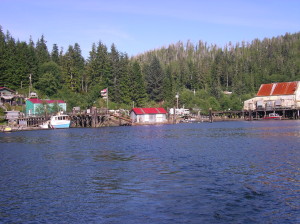
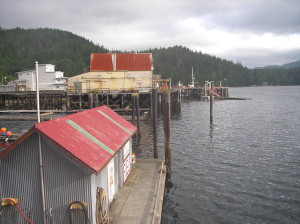
A Fishing Tale
(from Winter Harbour)
This is a fishing story. Whatever your expectations, it does not borrow from truth. It is not told as a conflagration of transient morality; or as a chain of worsening events remarkable only for their implausibility. No, this tale is simple and real.
In that respect, I am here to share with fishers, and their pretenders, the benefits of a long line and stout hook. The defendability of my tale lies far from attesting eyes, away from the questioning soul who cannot fathom the strange and beautiful creatures found at depth. No, some only know of the shallows, sometimes visited but only slightly reckoned, while here in the deep lay mystery and darkness, rumour and legend.
I have witnesses, you see. They would confirm this one odd occasion. It lives in me as a fine memory; I imagine for a lifetime. Whole seasons exist for one such impression, revisited as in a dream every so often, now and then forgotten but always there. For who can live this way each day?
My tale begins at the height of the summer season, always fertile times for Canadian tales, tall and piscine. Four men push their way up the inner thoroughfare of Vancouver Island, that meandering asphalt which connects the sparsely inhabited north with the heavily populated south, appropriately called the Island Highway. We are on our way to a place called Winter Harbour.
Our group includes Rob, a sturdy soul and our de-facto leader, who sometimes plays on three different hockey teams during house-league season. Rob can fix anything and is prone to moody introspection. I took Rob fishing for his first time on the west-coast to a place on the Fraser River called the Grassy Bar. That day his focus and determination resulted in him out-fishing me, catching a 45 pound chinook salmon from shore. He cleared the whole bar of dozens of fisherman as he pursued the catch at the end of his line down the 200 yard length of sand and rock until finally landing it with just feet to spare. He has mostly out-fished me since.
Also with us was Shawn, the boat owner and electronics wizard who can drink a flat of beer in a day and still maintain a pleasant demeanour. He is one of those problem-solvers, approaching life and friendships with grace and confidence.
Al tagged along that day too, a perpetual searcher, now middle-aged, who had still not found himself but is genuinely funny and easy to be around. He could shave twice and still have a five o’clock shadow, his hairiness an evolutionary indication of his virility. Al is a womanizer; his history a road map to broken hearts.
And me, nominally in charge of tackle, more experienced than the others but not the best fisherman. It was matching the gear to the task and seeing results that pleased me most. Each year I welcomed this break from civilization and a chance at male company.
Assuredly, there would be both adventure and wonder from a visit to Winter Harbour.
Winter Harbour is historically where the noble west coast trolling fleet, having assembled for more than a hundred years from California to Alaska to plunder the bounty of sockeye salmon that arrived by the tens of millions each year, sought safe-haven from the savagery of the sudden storms of the North Pacific. At one time, her waterfront was lined during the cold months with beer parlours, gambling houses and comely ladies of the night who serviced the captains and crews during the long breaks from sea.
This fishery has been significantly diminished over the past few decades. Perhaps that’s because of habitat losses up and down the coast; moreover, the decline has been enhanced by the large seiners which can take out a whole river tributary run of fish in one set. These trollers, undoubtedly the most sporting and sound way of catching salmon, are now a fraction of their former numbers. A port that once hosted a thousand ships now finds it is visited by just a handful each year.
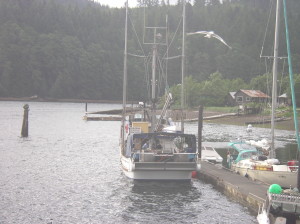
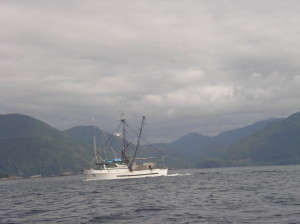
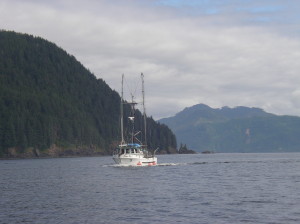
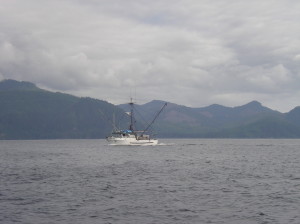
To survive, Winter Harbour has let out her secret: that she is on the doorstep of accessibility, the first Pacific Ocean side sound encountered at the top of the island. There, the annual run of salmon race down the coast from Alaska, skirt the island in great schools of inside and outside passage travelers, each returning to their nascent river to spawn and die. By pushing through a better dirt road some years ago, the harbour is now barely kept alive by gate-keeping for those who can brave the weather and waves in pursuit of Canada’s most abundant sport fishery.
Quatsino Sound is the name of the varied body of water that reaches thirty miles in-land, almost bisecting the top of the island in the process, and which shelters our base of operations at Winter Harbour. Each year she fills with huge chinook salmon returning to the Marble river, some more than a hundred pounds, after they’ve fattened up on herring and anchovy for 3 to 7 years while climbing the coast and finally feeding in the Bering Sea before lazily turning around in a wide loop and returning home. She gets a huge run of Sockeye and Coho; moreover, Pink salmon in odd years, too numerous to count.
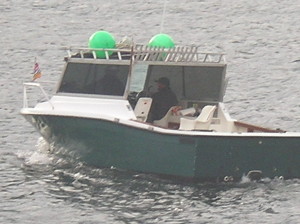
Our custom is to fish from this haven out of Shawn’s 26 foot Trophy, a brand that is an all-around boat of choice for sport fishing in the wild Pacific off the west coast of British Columbia. We had fished from an all-welded aluminium boat the year before that was only 12 feet long. The looks of incredulity from other boat captains as we drifted by them miles out to sea signaled that we needed an upgrade. Winding up sideways momentarily on the lee side of a wave after the wind kicked up late afternoon one time drove the point home. The twelve-footer now sits in my garage.
We picked up Shawn’s Trophy from a derelict back yard and spent a winter re-fitting her with new electronics, wiring, paint and practically everything else until we were satisfied she would perform as we wanted. Much of Rob’s, Shawn’s and my free time were devoted to her repair. Big Rob rebuilt her motor to a dependable state. We even put a custom roof on her, fabricating one of steel the first season until we procured an aluminium welder and re-made one in the lighter material for the next year.
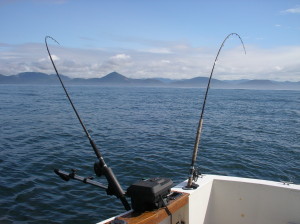
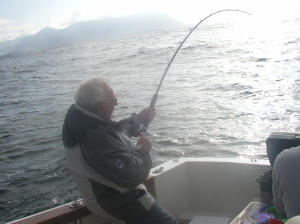
We usually take turns targeting salmon one day and bottom fish the next. Sometimes we forego salmon fishing until the second week of our trip because our skill-set has risen to a level where we might catch our limit in a day or two. Or it’s just that there are so many we look good in the process. So we tend to bottom fish for halibut instead, supplemented by pacific rockfish, ling cod, flounder and sometime prawns. We carried the necessary equipment for it all, I made sure of that.
Halibut have a delicately flavoured white meat that is renowned for its taste, texture and flakiness. Indeed, one could easily be satisfied with this type of fish over all others; even foregoing salmon if necessary. They can reach into the hundreds of pounds, and at this size they are referred to as “barn doors”. The best eating size for halibut will be in the range of 15 to 75 pounds, referred to as “chickens”.
The much heavier fish will be too fatty and coarse for the best culinary experience. Still, the challenge of catching such a tremendous specimen has us trying all manner of innovations each year – in the quest for a champion photograph at least. What is of crucial importance to the viability of the species is found in these gargantuan sized female halibut: They carry hundreds of thousands of eggs to be fertilized each year. In a sense, they are the true chicken factories of the sea. We never caught one over 80 lbs.
One fishes for “Hallies”, as they are known, with stout rods of less than five or six feet, and robust reels that can hold as much as 600 or more feet of line. The terminal tackle used requires a set-up strong enough to withstand not just the assault of fishes from below, but also the many ways it can become snagged on the sea-floor.
We preferred to use bait and fish deep and so we used a specific setup: usually a heavy gauge, inverted L-shaped wire rig is employed where, at the short end, a weight of between 1 and 3 pounds in affixed and, at the longer end, a 15 inch leader of 200 pound test line is attached. At the end of that we’ll use a double system of circle hooks as large as the C you can form with your thumb and forefinger. On these we carefully wind on bait-fish, cured and preserved in a brine of sea-salt to make them tougher.
This whole contraption is carefully lowered some 300-400 hundred feet to bounce along a sea floor carefully scrutinized for sandy bottom around one of the many humps located after carefully study of oceanographic maps. These small rises on the ocean bed will contain many small schools of other fishes, offering the halibut dinner as it glides along the bottom in search of prey.
In this blind pursuit, all manner of incidental catches occur. We have pulled up rays, sharks and flounder, and a wide assortment of colourful rock-fish like the ubiquitous yellow-eye, but also the green and the china. As well, massive ling-cod, those assassins of the deep, sometimes to 50 pounds or more, that can mangle bait and line fairly regularly. And then there are the pesky dogfish, sharks that are so abundant that they constitute an annoyance rather than good purpose.
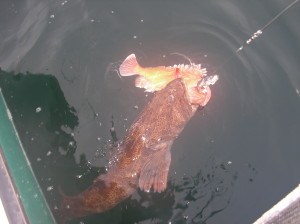
At 400 hundred plus feet down, one never knows what one has on the line. There is a long and arduous reeling-in, while often dealing with great tugs and shakes under bent rod as we pull back to gain line and then giving back some of same as the prey tears away beyond the drag-set in an attempt to escape. To the defeat sometimes felt as the foe releases on their upward journey, often just a few turns of the reel from the boat. And too, if we are lucky and have a good hook-set, and often after a 20 minute fight, we might bring to the surface whatever has caused this great expenditure of effort.
We do all this in seas that rise and fall ten or twenty feet, often with a one or two foot chop on her surface as well. And sometimes suffering, always in silence, the ill-effects of hours of sea-sickness, to where one’s balance and stance become expanded and conditioned to the shifting boat deck. We do this mostly without the aid of the horizon to help our queasiness, the coastal weather being mostly gray and often in fog, or the distance to shore too great to discern a shoreline or the mountains that we know are there. And we do so in the drizzle of rain, or it pours, with or without wind, but usually with, and rarely, but sometimes, gloriously, in full sun.
Even on this very trip, during a particularly windy day while Shawn was tacking back and forth to slow the inside rigger while speeding up the outside one to vary the presentation to our quarry far below, inadvertently, the down-rigger line became caught in the propeller. Since we were now stranded ten miles off shore, doing nothing was not an option.
So we lowered Rob by the ankles over the transom. Shawn and I, each holding a leg, bracing against the gunwale but without tying him off, watched in amazement as he reached into the 35 degree water, half-submerged, taking breaths before dunking his head repeatedly below the waves. Wrench in hand, he removed the prop, barely catching it with the other as the last turn of bolt holding it to the shaft let loose and the waves and current almost sent our means of return to land to the deep. He untangled the line and replaced the prop in seas approaching 18 feet, with a chop from the wind that begged for a small craft warning.
Remaining close to Rob’s head by the waves, having leaned over to lend support, Al’s play by play quips made a sorry situation bearable: on the spot, appropriately nick-naming Rob in a feigned French accent, “Monsieur Rob Cousteau, dep-seh meh-ka-nik” much to everyone’s continued amusement. Our enhanced laughter was no doubt in relief to the gravity of the situation from which we had luckily extricated ourselves.
Only a sometime fisher, I called Al the “rookie” on this trip. He could tell a joke much better than he could take one. But his quick mind could assess a situation and find the funny as fast as anyone I’ve known. That one stand-up act (and I use “stand-up” in its most liberal sense as we were tossed about by waves that day) almost made the whole trip worthwhile. My belly ached from laughter, no doubt from intense gratitude too.
It is our custom to give way to each other as the call of “fish-on” is heard on the boat. This being a largely unspoiled and nutritionally rich part of the ocean, it doesn’t take long for that to happen. Should the angler manage to negotiate their catch all the way close to the surface, we often look over the side in curiousity to see if the prey on the end of the line is of the desired type. Is it a dogfish, those opportunistic feeders that ruin tackle and are a source of such false hopes when their incessant tugging is felt at the line? Or is it another ling, who sometimes swim up to our bait and slam is as it passes by their lair deep below? Or, perhaps it is another rockfish, usually identified some twenty feet down by its bright orange colour, the yellow-eye being the most numerous, being hauled again to the surface, their swim-bladders extending from the expansion caused by the rapid ascent out of their mouths as if they had blown a giant bubble of pink gum?
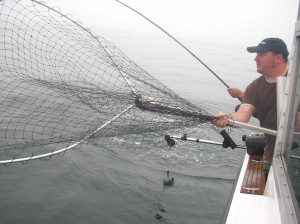
With salmon, one of us will do the honours by manning the huge net and standing beside the catching angler, attempting to reward his hard fight by deftly scooping their prize for them from the water and safely depositing the catch onto the boat floor. But when fishing the deep, where the prey is tougher and their skins are coarse – as protective as armour – one stands by with a gaff. This sharpened hook allows the helper to spear the prey from below with a deliberate upward thrust, and bring her securely on board where it will buck for air and bleed from its impalement until dispatched with a club. In the case of a “barn door” Halibut, they’d be first shot in the water with a 22 pistol and tied off to a cleat, lest they destroy the boat with their thrashing while in the death throes of the caught and condemned.
Soon after our adventure with the prop, what should have been a routine catch turned into something else entirely. I looked over the side as Shawn brought up his latest. Spying orange in the depths beside the boat, I announced it as a rock-fish, then immediately backed off to open the trap door to one of the fish holds. I stood there waiting. Al, as if living up to the rookie moniker I had given him, stood at the back of the boat holding his upright and now hastily bandaged hand after having sliced it open that morning cleaning a fish with my knife, reducing him to an observer. That left Shawn reeling in the catch and Rob manning the gaff. Rob suddenly exclaims “it’s no rock-fish, it’s an octopus!”
And, there it was: a Giant Pacific Octopus, at the surface and pissed off!
Peering between them, I saw it turn from orange to crimson along its three foot body as it thrashed about the waves besides the boat, firmly tethered by the huge hook in the shoulder of one of its limbs. The frothing sea came alive in front of us, with all manner of arms snaking in and out of the water as Rob and Shawn tried to tame the beast.
Rob gaffs the animal firmly but that seems to enrage it even further. It reminded me of a fight between men where, once someone is actually hit hard, the scuffle is intensified and becomes serious. Attempting to lift it into the boat became a task onto itself, but none of us could think of what we might do should we get it there. We were completely unprepared for this possibility, with each of us shouting suggestions and those strategies being foiled by the critter fighting for its existence as we made progress and lost it just as quickly. They managed to raise it up just out of the water but there they met the full force of its resistance. Rob had one hand on the gaff, Shawn two hands on the road. Both are bracing themselves in the waves up against the side of the boat as they try to overpower this deep sea mollusc. I am left alone, holding the door to the hold, wondering what’s holding them up, no room at the side to offer help.
With a mighty heave, both Shawn and Rob bring the beast up once more. At the apex of their effort, the hook becomes dislodged somehow, whether by the prey or one of us. I couldn’t tell for sure with my own eyes but Rob shouted that “the hook is out”, leaving me to imagine one of those swirling appendages finally de-mystifying the hold of that circle hook on its arm. That leaves the gaff as our sole connection to the quarry; however, I had full confidence that if that gaff were wielded by Rob, soon we would have as much halibut bait as we would need on ice in the hold.
But then, with only Rob’s two strong hands manning the gaff; with Shawn now just watching in disbelief, but backing off, less out of cowardice and more from helplessness; with Al, mouth agape at the same spot at the back, still holding his crimson bandaged hand, silent save for a sputtered word here and there; and with me still waiting by the hold but suspended in time, bewildered, that octopus wrapped its arms around Rob’s wrists like a python would around a rat.
With two more it pushed against the boat acrobatically, the equivalent to a sideways bench press, swinging out and leaving it several feet from the boat and several more above the sea to which it conveyed the impression it was tethered, as if the water were a solid it would not be separated from. The eye nearest us strained in the light, not from the effort it suggested, but with directed anger and hate for us instead. With still more determination, it sent out a feeler that inched along the top starboard rail, reaching back to the transom, a fast moving tentacle, skinny and curled at its end, followed by an ever-thickening appendage stemming from its body. And at the end of the back rail, where the starboard side gives way to the transom, it found purchase at a corner cleat to leverage against, and pulled hard for its life.
We did not hear agonized cries of pain, no grunts from herculean effort, nor were there screams or shrieks of frustration to be translated as invectives as such, since we were now so completely enthralled by the mysterious incongruity of the experience. It was a scene played out in frames. As if the tension between Rob and the gaff, the boat side where the agitated beast fought so valiantly, the corner of the transom opportunistically put into service and the eight legged alien were all increasingly stretched out like a rubber band, finally to the breaking point. Something had to give.
Suddenly, it was gone. It slipped beneath the waves and returned into the deep like its visit to the top was just a look-see, wasting no time in goodbyes or even a backward glance from its protruding gaze, as if contempt for us made us unworthy of the gesture. We watched embarrassed as the cephalopod kited quickly at an angle down through the blue-green waters and disappeared intact into the darkness. We could see its form lead the descent, followed by all of its legs, still intact. It grew smaller and smaller until it vanished completely.
We were all pretty much speechless. When I spoke first, inquiring as to what happened, it was almost intrusive.
Shawn said nothing as he put away his rod, muttering only perhaps a syllable or two of what his mind must have been contemplating in reply. Rob did mention something meekly; in a rising voice I had never heard come from him before, almost whiny, the words catching in his throat, something about how slimy it felt on his wrists and hands. He then said no more, as if he had just heard himself but delayed by a few seconds. He walked away towards the front, looking down at the floor of the boat, avoiding eye contact as he made his way to the cabin to light a cigarette and stare off into the distance. Al, who always has something to say, this time remained solemn, knowing as all good comics do that this was no time for joking, the audience was elsewhere.
I too had nothing further as I retraced the experience in my mind lest I forget any of the details. I closed the hatch in front of me where I had been standing transfixed by it all. I sat against the rail and made no move yet to recast the lines, feeling the waves roll beneath me, contemplating one of the most unique encounters of our boat. It was a day before we could discuss it again, so thoroughly had we been bested, so discomfiting had been our reaction. In time, the only thing I could think of is that when confronting an eight legged quarry of this deep sea, the next time we better use all four guys.
But I am fine leaving this one and his kind where they are, it has earned that from me.
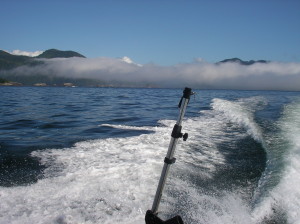
CHRISTOPHER K WALLACE © 2014, all rights reserved.
http://eepurl.com/bhlN7D











